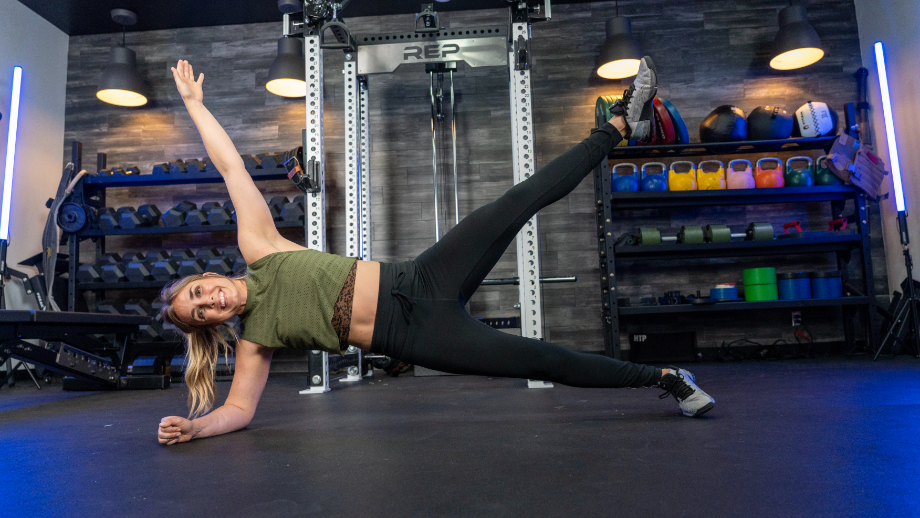We test and review fitness products based on an independent, multi-point methodology. If you use our links to purchase something, we may earn a commission. Read our disclosures.
Tired of doing the same movements over and over again? We’ve picked some that will test your strength and balance.
There’s a common misconception in the fitness industry that bodyweight exercises are “too easy” and don’t challenge muscles nearly as much as people need. And we’re here to say that people who think like that are just wrong, but we can also see where they’re coming from.
Look up any bodyweight exercise guide written before or during the COVID-19 pandemic and you’ll most likely see the same movements listed over and over: jumping jacks, push-ups, sit-ups, air squats, and so on. There’s nothing wrong with these moves, but to see muscle and strength gains, you need to do more.
That’s why we’ve put together our list of six outside-the-box bodyweight movements you should try to get a grueling workout in no matter where you are. These moves can be done with minimal equipment (you might need a chair), and take no time at all.
Think you’re ready to try them?
6 Bodyweight Movements You Should Try
We chose these six movements because they each target a different part of the body, can be modified to be easier or harder depending on your fitness level, and they’re not something you’d typically see on most bodyweight exercise guides.
Single-Leg Squat
The single-leg squat is just like a regular air squat, but, as you probably guessed, you’re only using one leg. You’ll have one foot planted firmly on the ground, with another suspended in the air as you try to lower into a full squat.
Why You Should Do It: Besides targeting the same muscles as a traditional squat (hamstrings, quadriceps, and glutes), a single-leg squat will task your core strength even more since you’ll be working harder to maintain your balance.
How To Do It:
- Stand on your right foot, extending your left leg straight with your left foot slightly off the ground in front of you. If this is too difficult, simply bend your knee and keep your left leg elevated.
- Keeping your core engaged, try to lower yourself into a squat: your thigh should be parallel to the ground while keeping your chest up and gaze ahead. Also take care that your right knee doesn’t cave in.
- Squeeze your glutes and push straight back up.
- Repeat with the other leg.
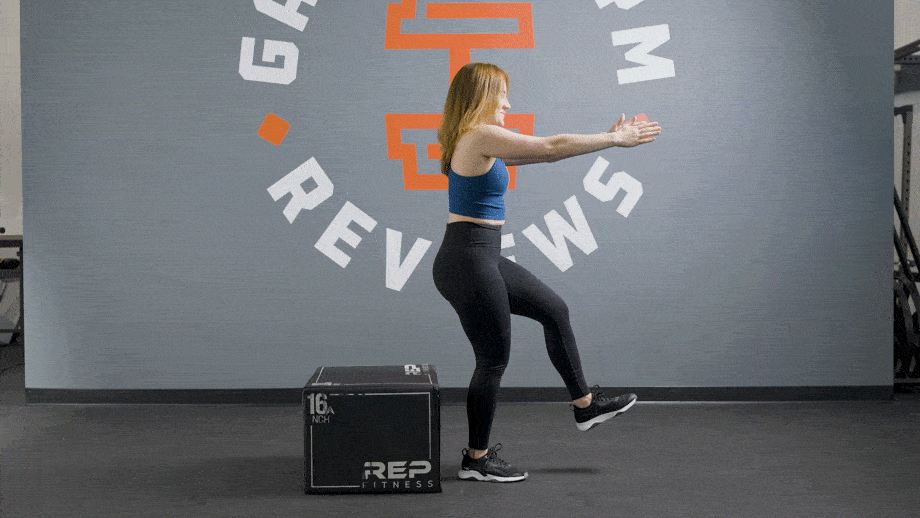
Variations:
Single-leg chair squat: Start by sitting on a chair and elevating one of your feet. Try to stand up on the one foot still planted on the ground, then sit back down. Repeat. Try this if you’re looking to work on your balance.
Assisted pistol squat: Holding onto something sturdy, like a squat rack post, elevate one foot in front of you, straightening your leg. Bend your other leg to drop into a squat while “walking” your hands down the pole for stability. Once you reach the bottom, push yourself back up while again “walking” your hands up the pole. Try not to rely on your arms too much.
Box pistol squat: Stand on the edge of a box or chair (the “seat” should come up to the top of your calves) with one foot hanging off the side. Begin lowering yourself as you would during a typical single-leg squat, lowering until your butt touches your calf. Stand back up and repeat.
V-ups
You’ve probably been doing sit-ups, or some variation of them, since you started exercising, but have you ever tried a v-up? As the name might suggest, this taxing move requires you to make a “V” shape with your body in a way that will light your core on fire. Don’t say you weren’t warned.
Why You Should Do It: The v-up is a full-body movement, but it primarily targets your abdominal muscles (external and internal obliques and rectus abdominis) and your hip flexors. If you can’t achieve the full range of motion, that’s fine. When you get to your limit, simply hold it there for as long as possible before going back to the starting position.
How To Do It:
- Lie flat on your back with your arms stretched above your head, legs together, and toes pointed straight.
- Keeping your legs straight, lift them up while simultaneously bringing your arms toward your feet, meeting in the middle of your body.Keep your lower back flush with the ground throughout the movement and avoid rounding your shoulders.
- Lower yourself back to the starting position in a controlled motion.
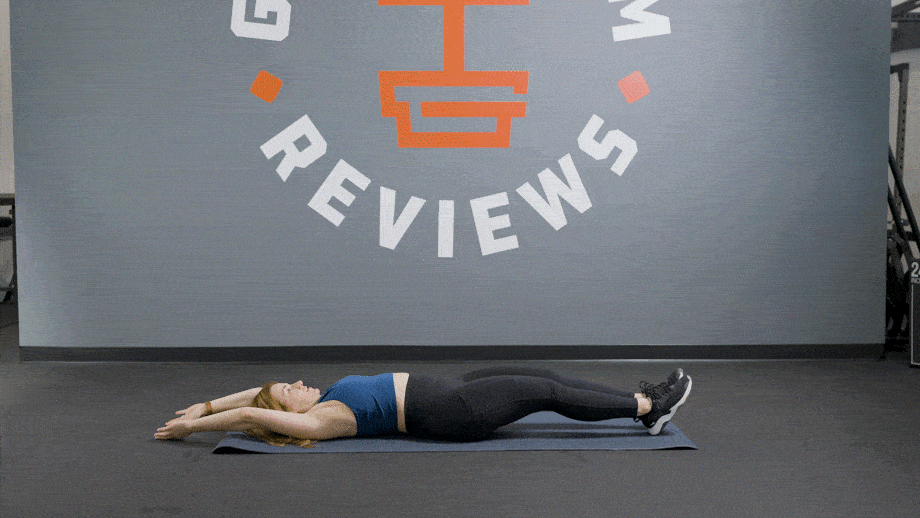
Variations:
Tuck-up: Not quite ready for the v-up? The tuck-up targets the same muscles and is basically the love child of a V-up and a crunch. Lie flat on your back with your arms straight above your head. Bring your knees to your chest while simultaneously raising your upper body off the ground, ending with your arms around your legs. Hold for a brief second, then return to the starting position.
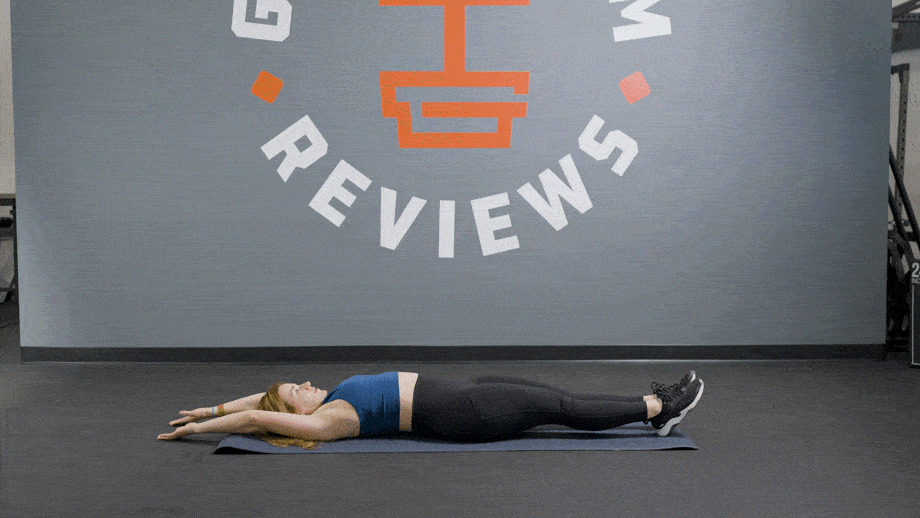
Single-side v-up (alternating): This is the same movement as the v-up, except you’re only bringing one leg and the alternating arm up at a time, meeting in the middle of your body. If your other leg keeps moving, try getting a friend to hold it down with gentle pressure.
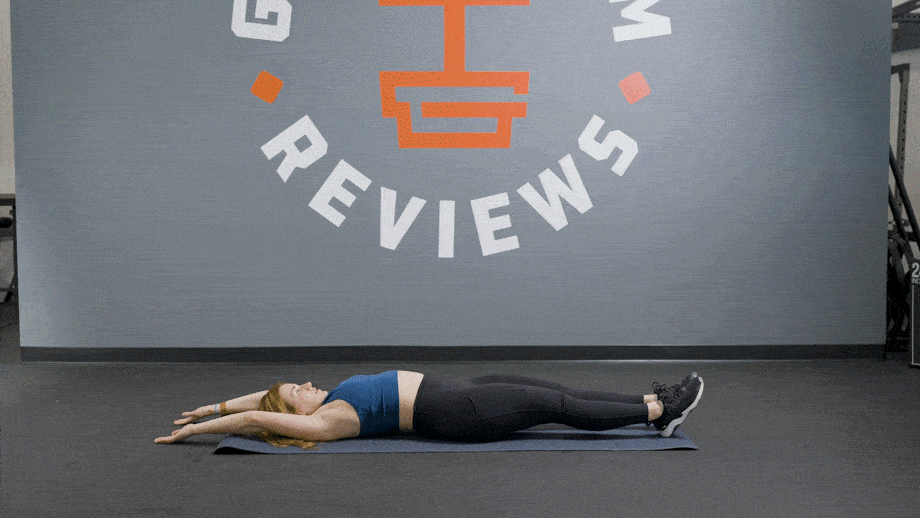
Batwings
This move looks simple, but the key here is to squeeze your shoulder blades together at the top of the movement to get the full benefits. Trust us, this will get harder the more of them you do.
Why Do It: This is a great exercise for the upper back and triceps, and is a great alternative if you don’t have a pull-up bar around.
How To Do It:
- Lie flat on your back.
- Use your triceps to push your shoulders, upper back, and torso off the ground, keeping your core tight the entire time.
- Squeeze the shoulder blades together at the top and hold for a brief second.
- Slowly return to the starting position.
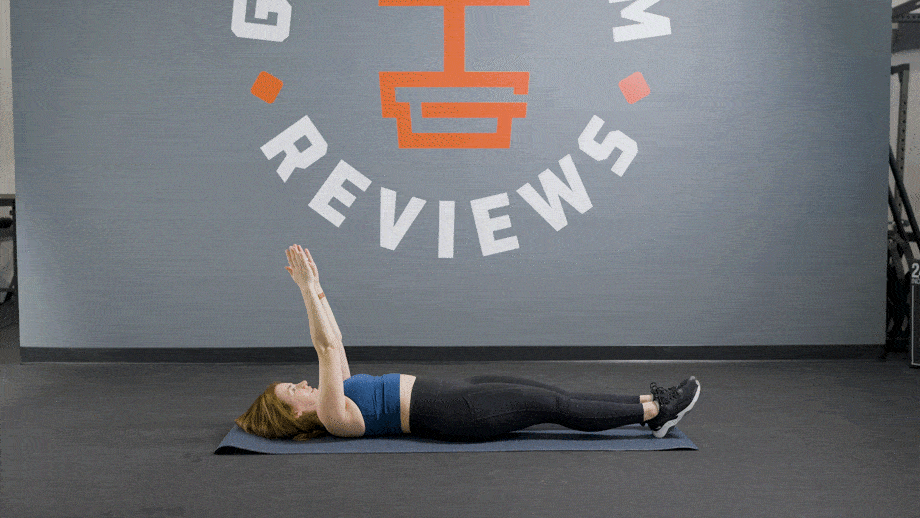
Froggers
If you’re sick of planking, try adding some spice to the movement by becoming a human frog. Well, not really, but you’ll see what we mean.
Why You Should Do It: Froggers work the entire body, and will get the heart pumping quickly, so it’s a great move to get a lot of bang for your buck.
How to Do It:
- Start in a high plank position with your body in a straight line.
- Jump your feet forward so they land just outside your hands, keeping your upper body stable the entire time.
- Jump your feet back to the starting position and repeat.
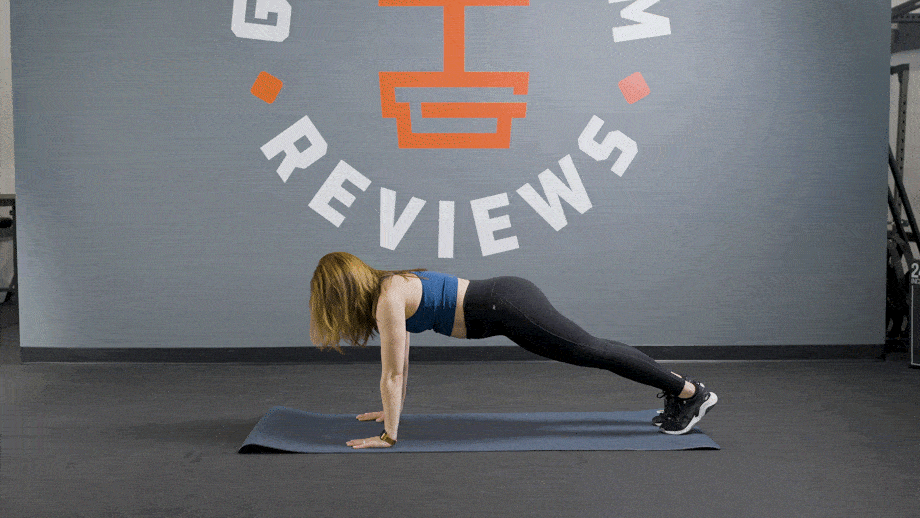
Copenhagen Adduction
Physical therapists like utilizing this move because it’s been shown to increase hip flexibility and can be done with a partner to ensure proper form is being followed at all times.
Why You Should Do It: Besides the aforementioned benefit for your hips, the Copenhagen adduction can help prevent future groin injuries.
How To Do It:
- Find an object (like a weight bench or a chair) that’s 1 to 3 feet high with space underneath it.
- Get into the side plank position off the bench, positioning one leg on top of it, and the other underneath.
- Keeping your body straight, lift your hips up and come up onto your forearm, getting your body into a straight line as you bring your legs together to meet.
- Slowly lower yourself back to the starting position.
- To make the movement easier or harder, find an object that’s closer or further from the floor.
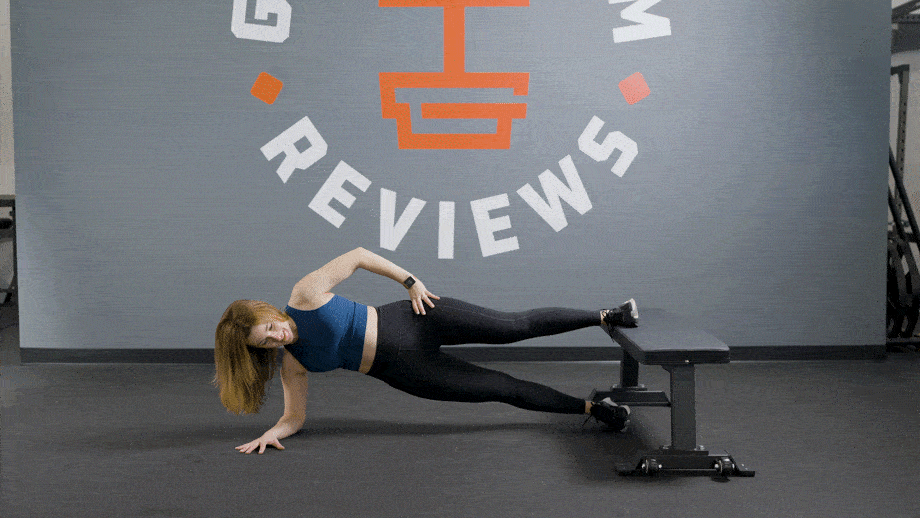
Variations:
Side-lying hip adduction: Lay on your side with your legs stacked on top of each other and your upper body propped up on your forearm. Bend the knee of your top leg and place your foot flat on the ground in front of your body. Slowly raise your bottom leg as far as you can, then lower in a controlled motion back to the ground.
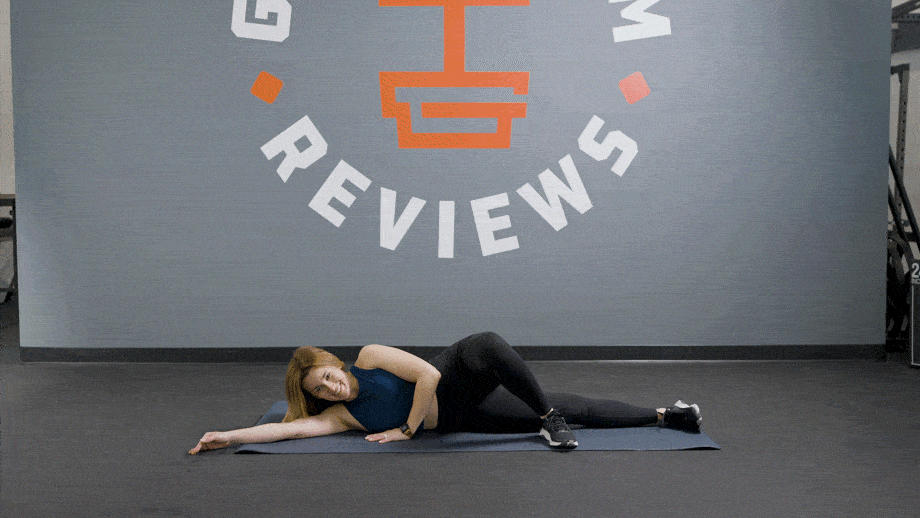
Pike Push-Ups
Ah, the push-up. Probably the most famous bodyweight exercise, and it’s still recommended by many because it works. But once you can drop and give us 20 with ease, it’s time to challenge yourself a little more. And that’s what the pike push-up is for.
Why You Should Do It: Pike push-ups are incredible for shoulder strength, and it’s one of the moves people try to master before graduating to something like a handstand. It’s also great for your shoulders, arms, chest, back, and core.
How To Do It:
- Start in a regular push-up position.
- Keeping your core tight, lift your hips and walk your hands back so your body forms a V-like shape, similar to downward dog.
- Keeping your legs straight, bend at the elbows, lowering the top of your head to the floor just in front of your hands, forming a tripod with your hands and head. (Note: You do not have to put your head on the ground, but if you do, make sure it’s the top of your head and not your forehead!)
- Hold the bottom position, then push back into downward dog and repeat.
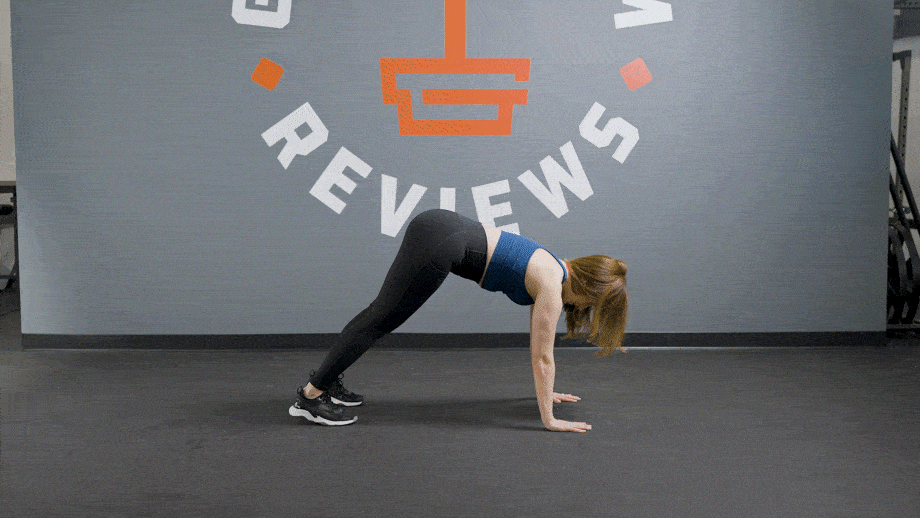
EMOM Bodyweight Workout
On the road, or maybe the gym’s a little too packed but you still want to do a quick workout? Try this every-minute-on-the-minute (EMOM) workout.
Here’s how it’ll work: You’ll work to hit the number of reps for each move within a minute—if you reach it before the minute is up, take the time to rest before your next 60 seconds start.
Minute 1: 10 single-leg squats (5 each leg)
Minute 2: 20 froggers
Minute 3: 10 Copenhagen adductions
Minute 4: 10 pike push-ups
Try for three rounds.
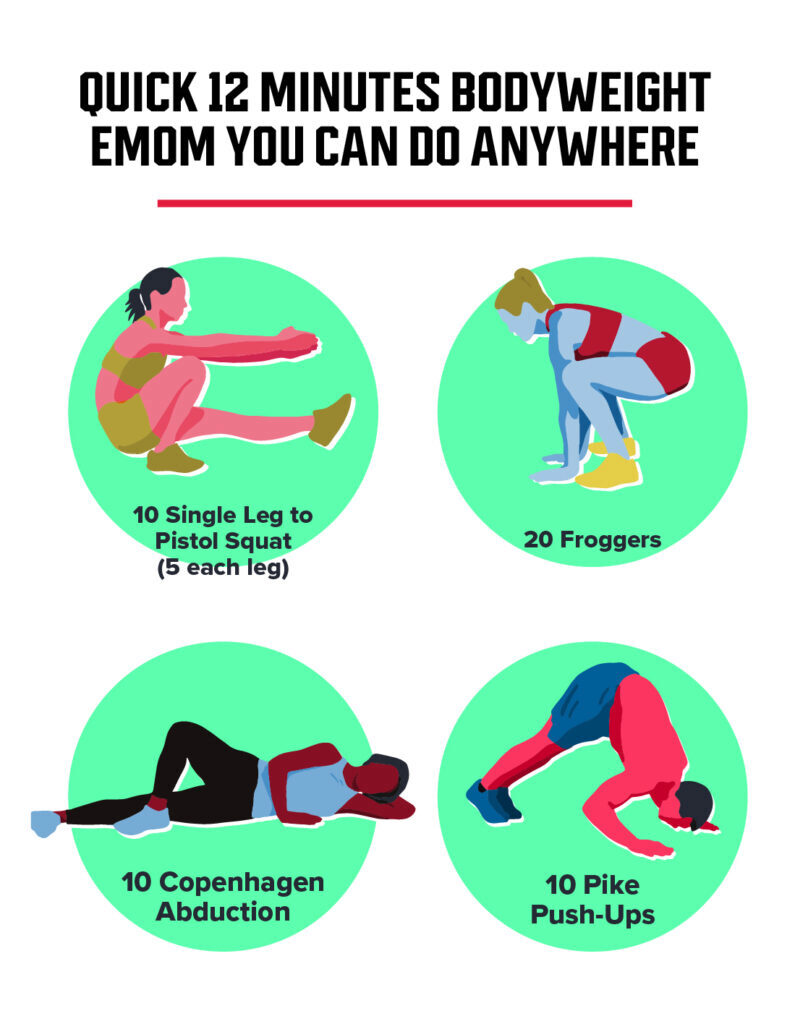
Do Bodyweight Workouts Work?
People have been doing bodyweight exercises for thousands of years, and it was the preferred training method of the ancient Greek Spartans (and they were pretty strong and muscular).
So yes, bodyweight exercises are an effective way to grow muscles and increase strength, especially for beginners. Multiple studies have proven this, and some have shown it can reduce the effects of aging, such as loss of balance.
There are also many online workout programs that solely rely on bodyweight workouts, and have helped thousands of people reach their fitness goals.
Busting Some Bodyweight Workout Myths
Bodyweight Workouts Don’t Build Muscle
There’s no truth to this whatsoever. Bodyweight exercise is a form of resistance training, which is essentially when your muscles are working against external resistance. For many people, that resistance comes in the form of a loaded barbell, but your body and the forces of gravity can also be a form of resistance.
Bodyweight Workouts are Easy
This might be many people’s opinions because, again, the same few moves have been recommended for decades, and they’re usually the easiest ones. Nobody would say bodyweight workouts are easy if they saw moves like a handstand pushup or froggers on a list.
You Don’t Need Rest Days
Just because you’re not using weights doesn’t mean your muscles don’t need a break. Whenever we engage in any form of exercise, our muscle fibers undergo microscopic tears that need to heal so they can grow. But if you workout every day, they won’t have ample time for recovery.
You Can’t Change the Resistance
There are many ways you can change the resistance of a bodyweight workout. You can either make your bodyweight heavier by wearing a weighted vest, doing the moves slower or incorporating pauses, or only working one side of your body at a time.
Bodyweight Exercises FAQs
Can I get ripped just by bodyweight exercises?
Bodyweight exercises can help increase muscle mass, and improve certain health markers, but body composition is heavily dependent on body fat percentage. If your goal is to lose weight while building muscle, you’ll need to ensure you’re in a caloric deficit (with enough protein!) while also engaging in resistance training.
Is it OK to do bodyweight workouts every day?
No, it’s important to give your body time to recover no matter what type of strength training workout you do.
Is bodyweight training better than weights?
If your goal is overall strength and muscle gain, weight training will provide those benefits quicker. Bodyweight training, on the other hand, can still help improve things like balance and core strength and is a great option for a beginner.
Our Take on Bodyweight Workouts
Bodyweight workouts have earned a bad rap in recent years, mostly because everyone keeps recommending the same moves despite countless articles being written about them. Again, there’s nothing wrong with these exercises, but they’ll only take you so far.
To increase muscle mass and strength, as well as train vital parts of our bodies to remain functional, we need to challenge them with new movements. And once you master the moves we’ve laid out for you here, try to find even harder ones.
Further reading

Our FLYBIRD Adjustable Dumbbells review looks to answer the question: Are these the best budget-friendly adjustable dumbbells on the market? Read more

Designed for the heaviest of deadlifts, we look at the overall value of this barbell in our REP Fitness Hades Deadlift Bar review. Read more

A personal trainer explains how time under tension workouts can help you reach fitness goals quicker, focus on proper form, and add variety to your training. Read more

Looking foLooking for a trustworthy nutrient boost? GGR's experts have rigorously tested and handpicked the best multivitamins for women, men, athletes, and more.r a trustworthy nutrient boost? GGR's experts have rigorously tested and handpicked the best multivitamins for women, men, athletes, and more. Read more

